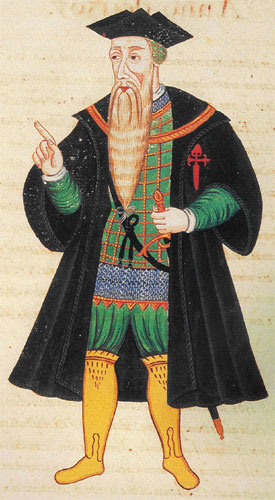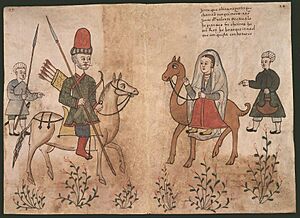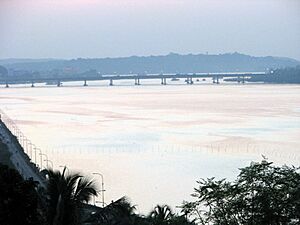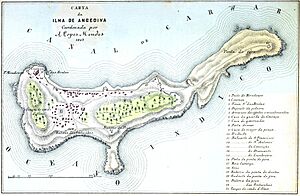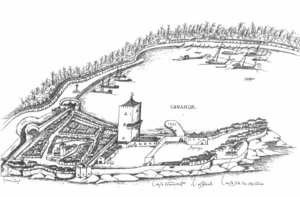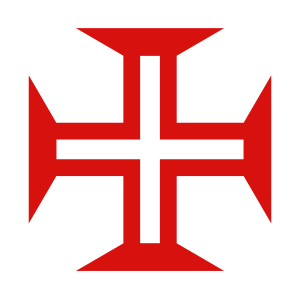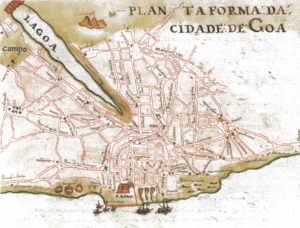Portuguese conquest of Goa facts for kids
Quick facts for kids Conquest of Goa |
|||||||||
|---|---|---|---|---|---|---|---|---|---|
| Part of Adil Shahi–Portuguese conflicts and Bahmani–Vijayanagar War | |||||||||
 Map of Goa, in Linschoten's Itineraries, ca. 1590 |
|||||||||
|
|||||||||
| Belligerents | |||||||||
| Portuguese Empire Vijayanagara Empire |
Bijapur Sultanate | ||||||||
| Commanders and leaders | |||||||||
| Afonso de Albuquerque Timoji |
Yusuf Adil Shah Ismail Adil Shah Yusuf Gurgij (WIA) Pulad Khan Rassul Khan |
||||||||
| Strength | |||||||||
| First attack: 1,600 Portuguese 220 Malabarese 3,000 combat slaves 23 ships 2,000 men of Timoji Second attack 1,680 Portuguese 34 ships |
First attack: over 40,000 men Second attack 8–10,000 men 200 cannon |
||||||||
| Casualties and losses | |||||||||
| First attack 200 Portuguese dead Second attack 50 dead 300 wounded |
First attack Unknown Second attack over 6,800 dead |
||||||||
The Portuguese conquest of Goa happened when Governor Afonso de Albuquerque took the city in 1510. He captured it from the Adil Shahis, who were Muslim rulers. Old Goa then became the main city of Portuguese India. This area included places like Fort Manuel of Cochin, Bom Bahia, Damaon, and Chaul. Taking Goa was not part of Albuquerque's original orders from King Manuel I. He decided to do it after a local leader named Timoji offered his help and guidance.
King Manuel I had only told Albuquerque to capture Ormus, Aden, and Malacca. Goa stayed under Portuguese control for a very long time, until 1961.
Contents
Why Goa Was Important
On November 4, 1509, Afonso de Albuquerque became the new Governor of the Portuguese State of India. Unlike the previous governor, Albuquerque believed Portugal needed to do more. He wanted to break the Muslim control over trade in the Indian Ocean. To do this, he aimed to control three key trade points: Aden, Hormuz, and Malacca.
Albuquerque also understood that Portugal needed its own strong base. They couldn't just rely on land given by allies like Cochin. A direct Portuguese base would make their power much stronger.
Preparing for the Attack
In January 1510, Albuquerque's forces failed to attack Calicut. He then went to Cochin to get more supplies and prepare for a new mission. He planned to attack Suez in the Red Sea. People believed the Mamluks were building a new fleet there to fight the Portuguese.
Albuquerque's force had 23 ships and about 1,200 Portuguese soldiers. They also had 400 Portuguese sailors, 220 local helpers from Cochin, and 3,000 support fighters. The group set sail for the Red Sea in late January 1510.
Near the Mount of Eli, Albuquerque told his captains his real plan. He had orders to take Hormuz. But he thought it was more important to destroy the Mamluk fleet first.
Then, the expedition stopped at the city of Honavar. There, a powerful local leader named Timoji met Albuquerque. Timoji told Albuquerque that it was risky to go to the Red Sea. He said that the Sultan of Bijapur, Yusuf Adil Khan, was gathering ships in nearby Goa. These ships were from a Mamluk fleet that had been defeated earlier. Timoji warned that they were being prepared to attack the Portuguese.
Timoji also said that Goa was not well defended. Yusuf Adil Khan had recently died, and his son, Ismail Adil Shah, was young and new to power. Timoji knew that the Hindu people of Goa were unhappy under Muslim rule. He offered to help Albuquerque capture the city. Albuquerque had already received messages from Timoji, so this meeting was planned.
Albuquerque then convinced his captains that attacking Goa was the right move.
First Capture of Goa
On February 16, the Portuguese ships sailed into the Mandovi River. With help from 2,000 of Timoji's men, the Portuguese landed troops. They attacked the fort of Pangim. A Turkish fighter named Yusuf Gurgij defended it with 400 men. Yusuf was hurt and retreated. The Portuguese captured the fort and some cannons.
At Pangim, Albuquerque met with important people from Goa. He promised them religious freedom and lower taxes if they accepted Portuguese rule. They agreed to support Portugal. On February 17, 1510, Albuquerque officially took Goa without a fight.
Albuquerque ordered his soldiers not to loot the city or harm its people. Breaking this rule meant death.
Inside Goa, the Portuguese found over 100 horses and 25 elephants belonging to the ruler of Bijapur. They also found new ships being built. This proved Timoji's information was correct. For his help, Timoji was made the chief tax-collector for the Hindus of Goa. Muslims were allowed to live by their own laws under their own judge.
Albuquerque expected the Sultan of Bijapur to fight back. So, he started preparing the city's defenses. The city walls were fixed, and the moat was made deeper and filled with water. Storage places for weapons and supplies were built. The new ships were finished and used by the Portuguese. Five crossing points into the island were defended by Portuguese and local troops with cannons.
At the same time, Albuquerque sent a friar to the nearby Hindu Vijayanagara Empire. He hoped to form an alliance against Bijapur.
Adil Shah Fights Back
Albuquerque did not know that Adil Shah had made peace with the Vijayanagara Empire. This meant Adil Shah could send many more troops to retake Goa than expected. He sent a Turkish general, Pulad Khan, with 40,000 soldiers. These included many skilled fighters from Persia and Turkey. They defeated Timoji's troops on the mainland.
Adil Shah then set up his camp near the Banastarim crossing. He waited for the monsoon rains to trap the Portuguese. Then he would order Pulad Khan to attack the island.
Albuquerque learned of this plan from a Portuguese man named João Machado. Machado had joined Adil Shah's service but was still Christian. He was sent to tell the Portuguese to surrender or leave. Albuquerque trusted his defenses and refused. Machado also told Albuquerque that Muslims inside Goa were telling Ismail about Portuguese numbers and movements.
When the monsoon rains came, the Portuguese faced serious problems. The tropical weather caused many Portuguese deaths. Food spoiled, and the Portuguese forces were spread too thin to stop the Muslim army. On May 11, Pulad Khan launched a big attack across the Banastarim crossing at low tide during a heavy storm. They quickly overwhelmed the few Portuguese troops. As the defenses broke, a Muslim uprising started in Goa's outer areas. The Portuguese quickly retreated into the city walls with help from their Hindu allies. They left some cannons by the river.
The next day, Pulad Khan attacked the city but was pushed back. Only then did Albuquerque learn about the peace between Bijapur and Vijayanagara. He spent the rest of May preparing to leave. Albuquerque did not burn the city, as that would show they were retreating. Instead, he ordered a lot of spices and copper to be scattered on the streets to slow down the enemy. Before leaving, he had Timoji and fifty of his men punish the Muslim people inside the fort. He also took some women from Adil Khan's household onto his ship. Before dawn on May 31, the remaining 500 Portuguese left under enemy fire. A few Portuguese soldiers held back the enemy troops who had broken through the city walls. Ismail then proudly took back the city.
Trapped in the River
On June 1, the ships sailed from Goa's riverfront to the mouth of the Mandovi River. They could not go out to the open sea because of the monsoon storms. The expedition was trapped on their ships inside the river mouth. For the next three months, they faced severe food shortages. They even had to eat rats and leather. They also faced constant Muslim attacks and harsh weather.
The river water was muddy, making it hard to catch fish and impossible to drink. However, heavy rain helped them get some drinking water. The Portuguese were also constantly attacked by cannons from the shore. These attacks, though not always accurate, forced them to move their ships often. They avoided firing back to save ammunition.
Many Portuguese soldiers jumped overboard and joined the enemy. They told the enemy about the lack of supplies. However, Adil Shah worried about new fights with Vijayanagar. He wanted to make peace with the Portuguese. He sent a messenger to propose peace. Albuquerque showed off his food and wine but refused Ismail's offer.
The governor visited every ship to boost morale and keep order. But his relationship with his captains got worse after his nephew, Dom António de Noronha, died. One officer, Rui Dias, disobeyed orders by meeting women captured by Timoji. Albuquerque ordered him to be immediately put to death. Several rebellious captains were arrested for a few days.
A Break in the Fighting
By August 15, the ships finally sailed out of the Mandovi River. The next day, they reached Angediva Island to get water. There, they met Diogo Mendes de Vasconcelos. He was leading four ships and 300 men. King Manuel I had sent him to trade directly with Malacca. Albuquerque knew that the previous attempt to open trade there had failed. He convinced Vasconcelos to reluctantly help him try to capture Goa instead.
Passing Honavar, Albuquerque learned from Timoji that Ismail had left Goa to fight Vijayanagar. An uprising had happened, killing many officers left behind.
Cannanore and Cochin
At Cannanore, they repaired their ships. They were joined by 12 ships from Duarte de Lemos and new ships from Portugal. The Portuguese now had 1,680 men and 34 ships.
Before going to Goa, Albuquerque was warned by the Raja of Cochin. The Raja was a loyal ally and needed help with a family power struggle. Albuquerque quickly sailed to help him. He quickly showed his strength, and the opposing prince was sent away. The King of Cochin's position was secured.
At Honavar, the Portuguese again met with Timoji. He told Albuquerque that Ismail had left a large force in Goa. This included 8,000–10,000 foreign fighters and local soldiers. Timoji offered 4,000 of his own men and 60 small ships. The king of Honavar also offered to send 15,000 men by land.
Second Capture of Goa
On November 24, the Portuguese sailed into the Mandovi River again. They anchored near Ribandar. Some men landed to check the city's defenses. Albuquerque held a meeting and explained his plan. He would attack the city from three sides. He divided his forces: one group led by himself would attack from the west. The other two groups would attack the city's river gates to the north.
At dawn on November 25, the attack began. Portuguese ships fired at the riverfront to clear the way for landing boats. Once ashore, the heavily armored Portuguese soldiers attacked the outer defenses. They used hand-thrown clay bombs to confuse the defenders. The Portuguese used their long pikes to keep the gates from closing. They broke into the city's fortified area as the enemy fled.
A soldier named Fradique Fernandes climbed the walls and raised a banner. He shouted "Portugal! Portugal! Victory! Saint Catherine!" This added to the defenders' confusion. Some defenders tried to gather near Adil Shah's palace. But they were defeated by a second Portuguese attack.
After five hours of fighting, the defenders were completely defeated. They fled through the streets and out of the city with many civilians. Many drowned trying to cross a narrow bridge. Others were chased by the Hindus of Goa.
Albuquerque could not join the attack on the city himself. The western defenses were stronger than expected. Timoji also arrived later. The governor spent the rest of the day clearing out enemy fighters in the city. He allowed his soldiers four days to take what they needed. The shipyards, warehouses, and cannons became property of the Portuguese Crown. The property of Hindus was not touched. The Muslims who had not fled were punished for helping the Bijapur army.
The Portuguese had 50 dead and 300 wounded, mostly from arrows. Albuquerque estimated that about 800 "Turks" and over 6,000 "Moors" (civilians and fighters) had died.
Defending Goa
With the city now firmly under Portuguese control, Albuquerque began to manage it and organize its defense on December 1, 1510. The old castle was rebuilt in a European style. It was manned by 400 Portuguese soldiers. A group of 80 mounted crossbowmen served as guards. A river guard was also created with several ships.
Timoji got his job back as chief tax-collector. But his low social standing and poor treatment of others caused problems among the Hindus. So, he was replaced by his rival, Melrao. Melrao had 5,000 men to help with defense.
With strong defenses in place, Diogo Mendes de Vasconcelos asked to go to Malacca. Albuquerque refused. Vasconcelos then tried to sail without permission. He was arrested, and his pilots were put to death. Albuquerque took command of the expedition himself. In February 1511, he left Goa for Malacca.
For the next year, the city was under attack by General Pulad Khan's forces. He had more soldiers and built a bridge and a fort at Benastarim. He took over the island of Goa but failed to capture the city itself. Pulad Khan was replaced by Rassul Khan, but he also could not retake the city.
During this time, the defenders had to stay on watch day and night. They also faced a severe shortage of supplies during the monsoon rains. Many left to join the enemy. But in this difficult time, João Machado returned to his Portuguese comrades. This greatly boosted morale. Machado also taught the Portuguese how to fight against the Indian tactics.
In October 1512, Albuquerque returned from Malacca with 20 ships and 2,500 new soldiers. With about 3,000 soldiers, it was time to go on the attack and secure Goa for good.
Attack on Benastarim
To fully control Goa, the Portuguese needed to take the fort Pulad Khan had built. This fort was on the east side of the island, about 6 km from Goa. It guarded a bridge that allowed enemy troops to cross from the mainland.
Albuquerque said the fort had 300 horsemen, many of them Turkish, and 3,000 ready fighters. The bridge was protected by two barriers in the river. Albuquerque ordered eight ships to destroy these barriers. Once done, the ships moved past Benastarim, blocking it from the river, and began firing cannons.
Before the Portuguese soldiers marched to surround the fort, 200 horsemen and 3,000 foot soldiers came out from Benastarim. They wanted to fight the Portuguese outside Goa. Albuquerque wanted to avoid a direct battle because the local soldiers were faster. But his soldiers insisted. So, Albuquerque gathered the Portuguese into four groups and went to meet the Muslims. The Portuguese cavalry charged, causing the enemy to flee back to the fort.
With the area now safe, the Portuguese decided to use their cannons to heavily bombard Benastarim. After eight days of constant firing, Rassul Khan decided to make peace with Albuquerque.
Albuquerque allowed Rassul Khan and his men to leave with their lives. In return, they had to leave their weapons and hand over about 19 Portuguese who had joined the enemy. Rassul Khan asked that these men not be put to death since they had converted to Islam. Portuguese rules also encouraged renegades to return. So, Albuquerque agreed.
What Happened Next
By taking Goa, Afonso de Albuquerque became the second European leader to conquer land in India since Alexander the Great.
Unlike other Portuguese military bases, Goa had many local non-Portuguese people. Albuquerque allowed different religious groups to live by their own laws. However, he quickly stopped the practice of sati, where a widow would burn herself on her husband's funeral pyre. Some taxes that were paid to Adil Shah were also removed.
Goa was an important trading port for war-horses from Hormuz. Albuquerque ordered that all ships bringing war-horses to India must unload them only at Goa. This made horse trade a very valuable source of income for Goa. Both the Vijayanagara Empire and the Sultanate of Bijapur wanted to buy horses there.
Albuquerque also made sure Goa had resources like rice and money to pay soldiers and sailors. It had skilled local shipbuilders and craftspeople to build and repair fleets. It also had gunsmiths to maintain weapons. This was important because it made Portugal less dependent on supplies from Europe. It helped ensure Portugal's continued presence in Asia. Having a strong naval base in Goa also helped Albuquerque's plan to disrupt Muslim trade in the Indian Ocean.
In Goa, Albuquerque started a fund for orphans and opened a hospital. Smaller hospitals were also built by a local charity to help the poor and local people.
Albuquerque also encouraged his men to marry local women and settle in Goa. He gave them land taken from the Muslims who had left. Local women were given legal property rights for the first time. This policy was popular with his soldiers. It also created a group of mixed-heritage people who supported the Portuguese Crown.
Albuquerque's policies were very popular with his soldiers and the local people. He was known for being very fair. When Albuquerque died in 1515, even the Hindu people of Goa mourned him. His tomb became a shrine where local Hindus would leave flowers and pray to him for justice.
In 1520, the Portuguese expanded their rule south to the Rachol district. The Emperor Krishnadevaraya of Vijayanagara captured the Rachol Fort and gave it to the Portuguese. This was in exchange for mutual defense against the Muslims.
In 1526, King John III gave Goa the same legal status as Lisbon. This document detailed the laws and rights of the city, its government, and the local Hindu community. This was important because Goa's local laws were not written down at the time.
Albuquerque wanted Goa to be the center of the Portuguese Empire in Asia. But it was not until 1530 that Governor Nuno da Cunha officially moved the main government from Cochin to Goa. This made Goa the capital of Portuguese State of India until 1961.
See also
- History of Goa
- Capture of Malacca (1511)
- Velhas Conquistas
- Luso-Indian
- Siege of Goa (1517)


